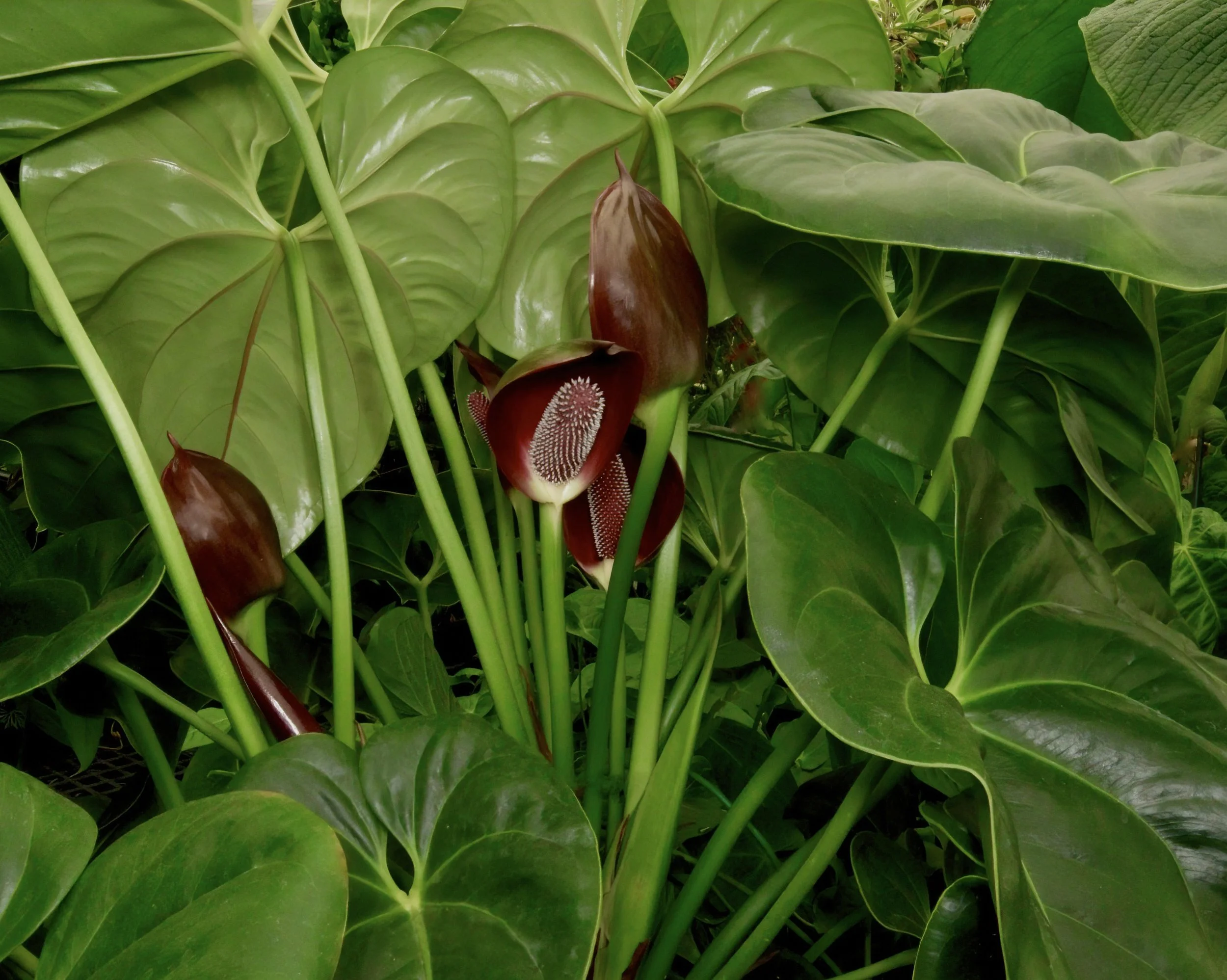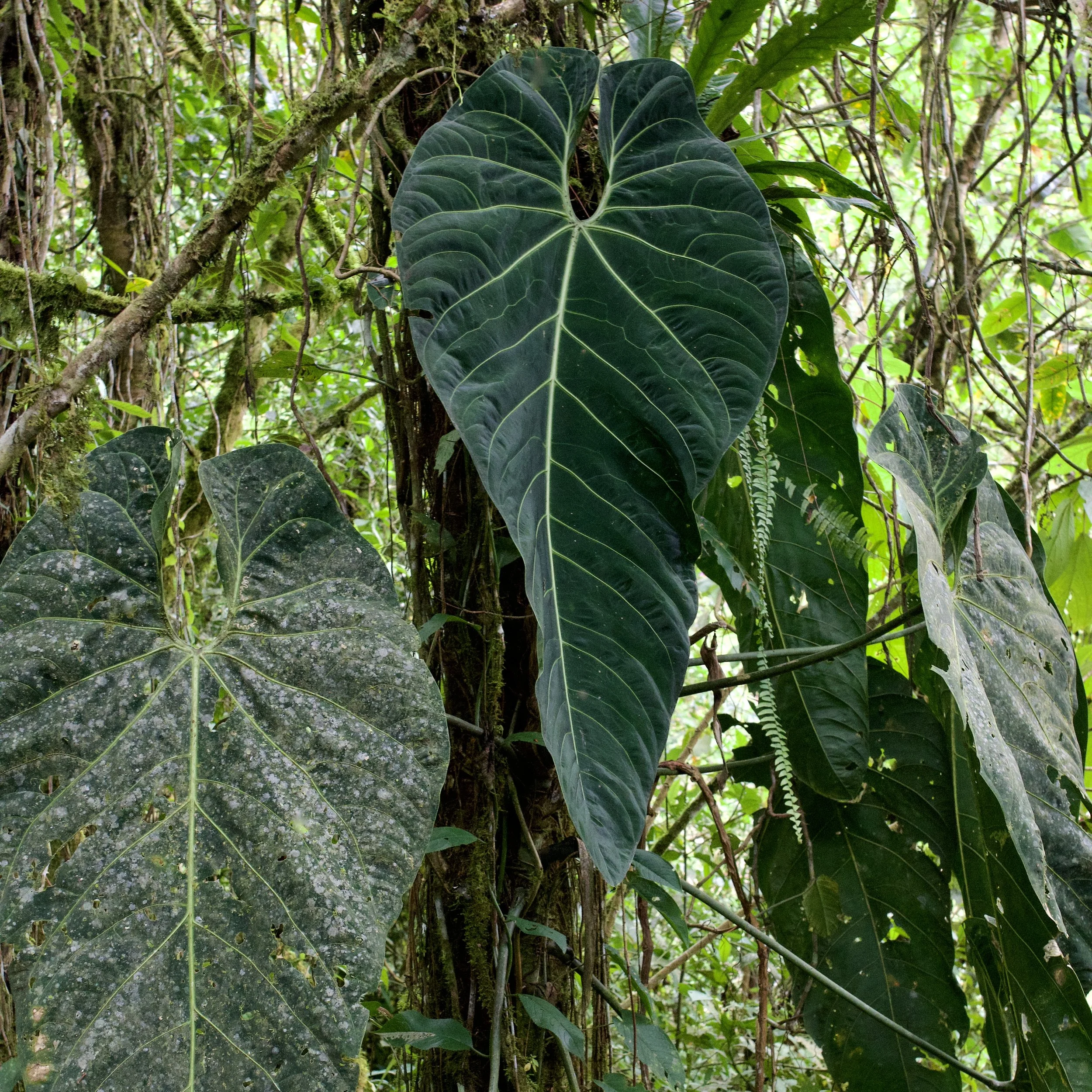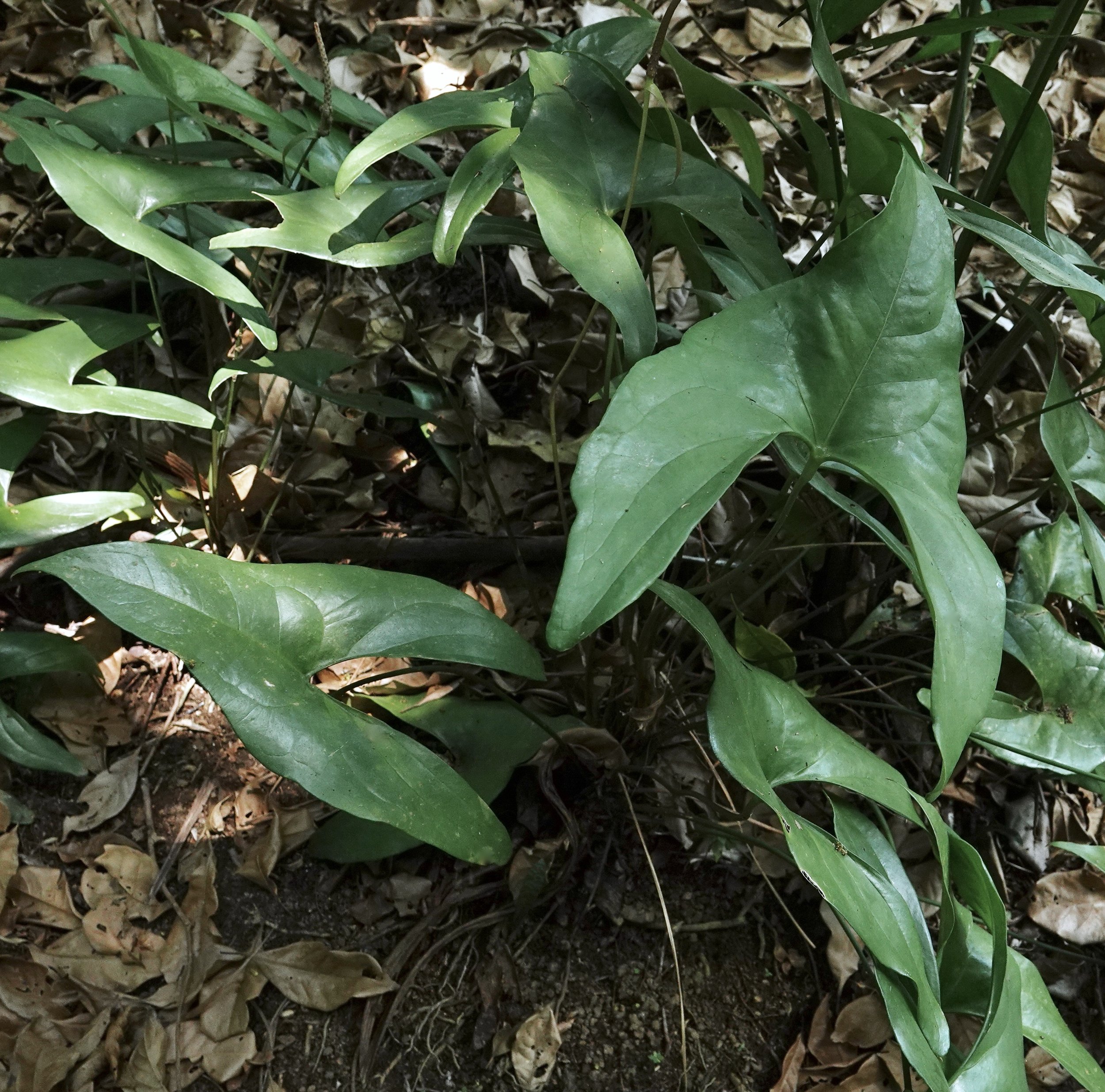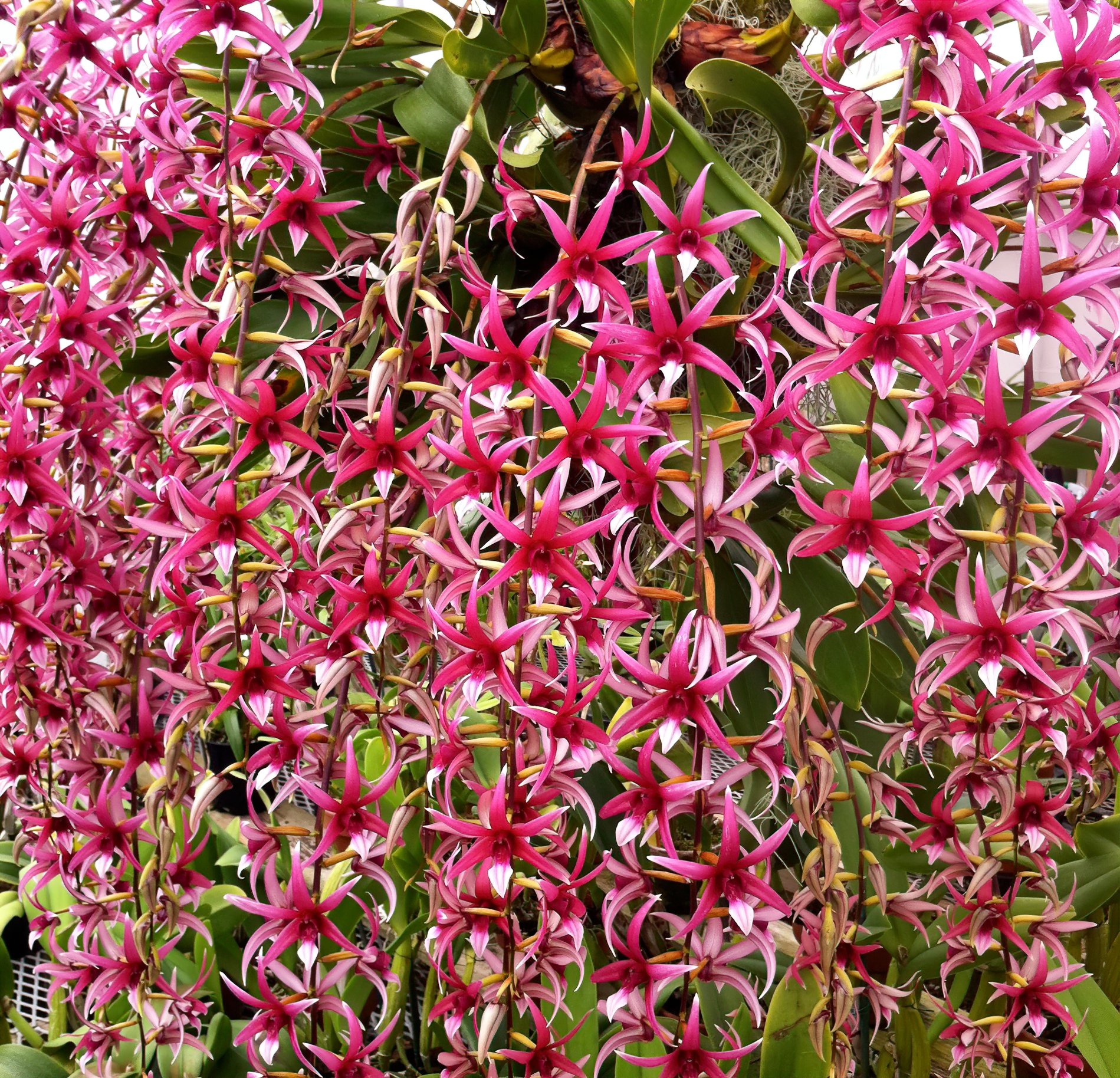A Collector’s Look at Anthurium Hybrids and Hybridization
Part I - Floral Selections
Rothschild’s Creation, Mistaken Identities and Spathe Oddities
By Jay Vannini
A large Anthurium kamemotoanum flowering in my California collection in 2022. Divisions of this exceptional individual have been shared with several aroid specialists in Guatemala and the U.S. This plant is 4’/1.25 m in diameter across the foliage. Image: © J. Vannini
One of the more conspicuous trends apparent in the early 21st century tropical foliage collecting phenomenon is the tremendous surge in interest in select aroid cultivars and hybrids. While all major ornamental aroid genera have been hybridized to create desirable pot plant novelties–many since the mid-1800s–it is the genus Anthurium (Schott, 1829) that leads all others in numbers of commercially valuable hybrids.
And by a wide margin.
Anthurium hybridization on an economically significant scale began in the late 1880s and followed the introduction of Anthurium andraeanum Linden to Europe in 1876. The first documented primary hybrid with decorative spathes, A. x ferrierense*, was published in 1883. Over the next two decades, dozens of named A. andraeanum-based hybrids appeared for sale in the northern European horticultural trade as well as in garden magazines and scientific publications.
Due to the promiscuity of many species in this genus, their popularity in tropical gardens and greenhouses, and their attraction to non-specific insect pollinators, it is no surprise to find that besides published cross and cultivar names there are also a confusing number of open-pollinated hybrids that have made it to market over the past 140 years.
Man-made hybrid Anthuriums fall into three main categories:
Those produced for the cut flower trade, which are selected for large, sturdy, long-lasting and showy-colored spathes with elongated stems that facilitate their use in mixed tropical floral arrangements. Most of these hybrids can trace their genetics back to the 19th century discoveries of Anthurium andraeanum and A. nymphaeifolium.
Those bred for use as pot plants in interiors or mass planting displays that combine attractive glossy green or reddish foliage with an ever-blooming habit that are selected for vigor and ease of care, coupled with showy-colored spathes. Some of these are dual-use plants and their cut stems can be used in floral arrangements. Most of these hybrids involve some combination of Anthurium andraeanum, A. nymphaeifolium, A. formosum, A. kamemotoanum, A. amnicola, A. antioquiense and A. antrophyoides.
Foliage hybrids that are selected for their ease of culture and attractive leaf morphologies: Leaf quilting, velvety aspects or leaf pebbling, and high contrast vein patterns. Until recently, these hybrids tended to be dominated by Anthurium crystallinum and lookalike taxa, A. forgetii, A. magnificum and lookalike taxa, as well as A. regale. A few novelty hybrids involve the southeast Mexican velutinous-leaf species, A. clarinervium and A. leuconeurum. Since the late 1990s, but especially over the past decade, collector interested has shifted towards so-called “Black velvet” hybrids bred for interiors and advanced grow tents that favor compact sizes, high leaf number and deeply saturated leaf colors ranging from chocolate brown through blackish green and violet to true black. These hybrids are mostly derived from A. papillilaminum and A. dressleri together with a small number of recently discovered or undescribed taxa native mostly to lowland Tropical Rain Forest in eastern Panamá and western Colombia.
One of the more conspicuous trends apparent in the early 21st century tropical foliage collecting phenomenon is the tremendous surge in interest in select aroid cultivars and hybrids. While all major ornamental aroid genera have been hybridized to create desirable pot plant novelties–many since the mid-1800s–it is the genus Anthurium (Schott, 1829) that leads all others in numbers of commercially valuable hybrids.
And by a wide margin.
Anthurium hybridization on an economically significant scale began in the late 1880s and followed the introduction of Anthurium andraeanum Linden to Europe in 1876. The first documented primary hybrid with decorative spathes, A. x ferrierense*, was published in 1883. Over the next two decades, dozens of named A. andraeanum-based hybrids appeared for sale in the northern European horticultural trade as well as in garden magazines and scientific publications.
Due to the promiscuity of many species in this genus, their popularity in tropical gardens and greenhouses, and their attraction to non-specific insect pollinators, it is no surprise to find that besides published cross and cultivar names there are also a confusing number of open-pollinated hybrids that have made it to market over the past 140 years.
Man-made hybrid Anthuriums fall into three main categories:
Those produced for the cut flower trade, which are selected for large, sturdy, long-lasting and showy-colored spathes with elongated stems that facilitate their use in mixed tropical floral arrangements. Most of these hybrids can trace their genetics back to the 19th century discoveries of Anthurium andraeanum and A. nymphaeifolium.
Those bred for use as pot plants in interiors or mass planting displays that combine attractive glossy green or reddish foliage with an ever-blooming habit that are selected for vigor and ease of care, coupled with showy-colored spathes. Some of these are dual-use plants and their cut stems can be used in floral arrangements. Most of these hybrids involve some combination of Anthurium andraeanum, A. nymphaeifolium, A. formosum, A. kamemotoanum, A. amnicola, A. antioquiense and A. antrophyoides.
Foliage hybrids that are selected for ease of culture and attractive leaf morphologies: Leaf quilting, velvety aspects or leaf pebbling, and high contrast vein patterns. Until recently, these hybrids tended to be dominated by Anthurium crystallinum and lookalike taxa, A. forgetii, A. magnificum and lookalike taxa, as well as A. regale. A few novelty hybrids involve the southeast Mexican velutinous-leaf species, A. clarinervium and A. leuconeurum. Since the late 1990s, but especially over the past decade, collector interested has shifted towards so-called “Black velvet” hybrids bred for interiors and advanced grow tents that favor compact sizes, high leaf number and deeply saturated leaf colors ranging from chocolate brown through blackish green and violet to true black. These hybrids are mostly derived from A. papillilaminum and A. dressleri together with a small number of recently discovered or undescribed taxa native mostly to lowland Tropical Rain Forest in eastern Panamá and western Colombia.
Part I of this article will examine the history of plants in the first two categories, with initial emphasis on the more noteworthy wild-origin plants that have been used to create the floral novelties discussed later.
The most recent figures available for U.S. wholesale trade in Anthurium flowering pot plants shows almost USD 12 MM in sales for 2019 derived from 1.82 MM individual plants and 80 reporting entities (USDA, 2020). Published financial statements for Anthura B.V. and its 14 corporate subsidiaries show calendar 2021 sales exceeding USD 118.58 MM (Dun & Bradstreet online, 2022). Royal FloraHolland’s financial reports for FY 2020 showed sales of € 62.00 MM from 21 MM Anthurium pot plant units (so, ca. € 2.95/USD 3.10 per unit), versus € 422.00 MM/USD 445 in sales from 117 MM Phalaenopsis orchids pot plant units (ca. € 3.60/USD 3.80 per unit). These figures represented steep year-over-year declines in revenues from 2019 high water marks attributable to the global economic impact of the COVID pandemic (Royal FloraHolland, 2020).
In the U.S., Anthuriums are currently the third largest floriculture crop in Hawaii. Both floral and ornamental foliage types have long been very popular there as garden plants and for the local and mainland cut flower trade (Neal, 1965; Amore et al., 2017). Anthuriums are commonly associated with the Hawaiian Islands in visitors’ eyes and are ubiquitous as motifs in visual art and floral-patterned “Hawaiian shirts”.
Demand for Anthuriums is also high in several Asian countries known to have large domestic production of these plants for both floral design and pot plants, especially India, Thailand, and the PRC. Breeding for select forms with desirable qualities for local markets is ongoing in these countries. Current figures released by online trade magazine FloralDaily report 40 MM Anthurium pot plants, produced mainly in Guangdong Province and Tianjin are produced annually for the mainland Chinese market, where Dutch Anthurium producer Anthura B.V. has had a major corporate presence since 2007 (Floraldaily.com, 2018 and 2022).
Contemporary trade in both wild origin and artificially-propagated Anthurium plants (mostly species) from countries of origin such as Colombia, Ecuador and Perú is likely substantial in economic terms as well. Despite heavy commercial pressure put on some species with showy colored spathes in the late 19th century they are surprisingly poorly represented in specialty collections today. This is likely due to their large mature sizes and specialized needs - especially cool nocturnal temperatures. All three of these countries also produce large numbers of hybrid Anthuriums with colorful spathes for the local floral trade and export markets
Unsurprisingly, at least to a cynic, a cursory search of commonly used Anthurium names on the internet reveals a disheartening number of images of obviously misidentified species and hybrids.
*Although Anthurium x ferriense Bergman was the first published A. andraeanum hybrid, the significantly longer length of time required to raise A. x mortfontanense André from pollination to flowering size (at least four years versus three or less in both pure A. andraeanum and A. x cultorum types - pers. obs.) strongly suggests that the latter was almost certainly made at the same time; likely in early 1880, so several years after A. andraeanum created such a splash by flowering in ornamental horticulture on the Continent.
Anthurium scherzerianum flowering in nature as a trunk epiphyte at ~6,000’/1,850 masl above Cartago, Cartago Province, Costa Rica. Image: ©M. Graupe
Showy spathes on a four year-old specimen the author’s hybrid, Anthurium andraeanum x A. kamemotoanum. Both species have been used extensively to create modern cut flower-type hybrids, but this appears to be first time this primary cross has been made with wild-origin plants. Image: ©Jay Vannini 2024.
To continue reading the rest of this and other premium content articles, please subscribe to Esotérica Exclusiva.
Access to deeper dives and behind the scenes looks into advanced tropical horticultural practices as well as observations on fieldwork, plant collection management, and Neotropical wildlife.
Follow us on:
Acknowledgements
Many thanks to Dr. Thomas Croat of the Missouri Botanical Garden for providing valuable information on several species as well as a number of beautiful images of Anthurium plants both in situ and in cultivation at the San Jorge Botanical Garden and at the Missouri Botanical Garden. Thanks also to famed plant illustrator Stig Dalström (www.wildorchidman.com) for sending me several copies of his superb artwork, including the exceptional illustration of Anthurium andraeanum in nature that was used for the poster for the IAS international conference in 1999. Chris Hall and Dr. Arden Dearden of Queensland, Australia provided the historically valuable image of the Herbert Bosworth’s unique Anthurium hybrid shown above, sleuthed the origins of many “red-leaf” Anthuriums in Australia, have been invaluable sources of information about the aroid collecting scene in Australia and SE Asia, as well as great friends all round for two decades. I would also like to acknowledge my long-time compañero, botanist and professor at the Universidad de San Carlos, Guatemala, Ing. Juan José Castillo’s many courtesies over the past 20 years together with proving a funny, unflagging, and fail-safe field companion in the back of beyond of Guatemala and Panamá. Fellow Esotérico Peter Rockstroh of Bogotá, Colombia provided background color on the various enterprises working with native Anthuriums in that country. My good friends Silvia and Mario Palmieri of Orquídeas S Y M in Guatemala have grown out a many noteworthy Anthuriums I left them when I moved to California, including selfings of A. ‘Red Beauty’ and others. Credits also to the late Lynn Hannon (d. 2006), Ivan Portilla of Ecuador, and an anonymous collector for providing the exceptional wild-origin forms of living A. andraeanum I have used in my own breeding programs since 2000. Dr. Barry Hammel provided valuable background information on Karl von Scherzer’s plant collections in Costa Rica, together with his own field experience with A. scherzerianum there. Bay Area photographer Michael Graupe provided a gorgeous shot of the same species taken in situ in central Ticolandian cloud forest. Fred Muller of Guatemala provided the image of a deep red new leaf on A. roseospadix taken in Panamá. Thanks once again to my friend Luis Molina of Antigua Guatemala for successfully growing on several of my A. x chelsiense and A. x mortfontanense selections together with select A. roseospadix founders that I left in his safekeeping back in 2012.
My friend and contributor to this site, Bill Lamar, carefully reviewed a near-final draft of this article and deftly excised its many warts. Any errors of style or content remaining in this version are all mine. ¡¡Mil gracias, ‘mano!!







